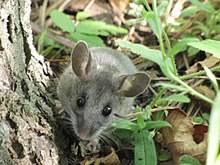| Peromyscus Temporal range: Late Miocene – Recent
| |
|---|---|

| |
| Peromyscus maniculatus | |
| Scientific classification | |
| Domain: | Eukaryota |
| Kingdom: | Animalia |
| Phylum: | Chordata |
| Class: | Mammalia |
| Order: | Rodentia |
| Family: | Cricetidae |
| Subfamily: | Neotominae |
| Tribe: | Reithrodontomyini |
| Genus: | Peromyscus Gloger, 1841 |
| Type species | |
| Peromyscus arboreus[1] | |
| Species | |
|
See text | |
Peromyscus is a genus of rodents. They are commonly referred to as deer mice or deermice, not to be confused with the chevrotain or "mouse deer". They are New World mice only distantly related to the common house and laboratory mouse, Mus musculus. From this relative, Peromyscus species are distinguished by relatively larger eyes, and also often two-tone coloring, with darker colors over the dorsum (back), and white abdominal and limb hair-coloring. In reference to the coloring, the word Peromyscus comes from Greek words meaning "booted mouse".[2] They are also accomplished jumpers and runners by comparison to house mice, and their common name of "deer mouse" (coined in 1833) is in reference to this agility.[3]
The most common species of deer mice in the continental United States are two closely related species, P. maniculatus and P. leucopus. In the United States, Peromyscus is the most populous mammalian genus overall, and has become notorious in the western United States as a carrier of hantaviruses.[4][5]
- ^ Wilson, D. E.; Reeder, D. M., eds. (2005). Mammal Species of the World: A Taxonomic and Geographic Reference (3rd ed.). Johns Hopkins University Press. ISBN 978-0-8018-8221-0. OCLC 62265494.
- ^ Cite error: The named reference
Crosslandwas invoked but never defined (see the help page). - ^ Deer mouse etymology from Merriam-Webster. Accessed June 11, 2010. Mw4.m-w.com (2012-08-31). Retrieved on 2014-01-05.
- ^ CDC – Hantavirus. Cdc.gov (2012-11-01). Retrieved on 2014-01-05.
- ^ What if ... Archived 2012-09-29 at the Wayback Machine. University of South Carolina